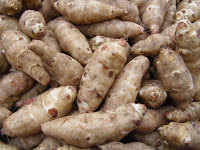
Introducing...your beets (if you're a veggie subscriber)! Because the weather has been so incredibly warm, I decided to go ahead and start seeding a few things outdoors. I couldn't resist. Usually, I've waited until April to do this, but April weather seems to have arrived in mid-March. It will be months yet before the average last frost date comes & goes, but things like beets, spinach, scallions & carrots are cold hardy and can take the cooler nights (and, with some row cover, even a light snowfall or two).
This is just the first planting of these veggies. They will get seeded again and again throughout the season so that we have a supply throughout the summer.
 Weeds have started to arrive with a vengeance over the last couple of weeks. Many of the weed seeds arrived with the manure that was added to the beds last fall. Even though it means weeding work, their appearance does mean that the manure wasn't contaminated w/ evil pyralid herbicides (something that is becoming disturbingly common). Soooo yeah...weeds are good, right?? Remind me of that in a couple months :-).
Weeds have started to arrive with a vengeance over the last couple of weeks. Many of the weed seeds arrived with the manure that was added to the beds last fall. Even though it means weeding work, their appearance does mean that the manure wasn't contaminated w/ evil pyralid herbicides (something that is becoming disturbingly common). Soooo yeah...weeds are good, right?? Remind me of that in a couple months :-). I experimented last fall and insulated my spinach & parsley beds with thick straw and several layers of row cover fabric. I wanted to see if I could get them to survive the winter.
 A couple of days ago, I uncovered them, and voila!! Live parsley, spinach & even some wayward scallions (don't know how those got there...maybe I dropped a seed packet last fall? Can't remember. I'm happy to see them though :-). The scallions look yellow because they apparently would've appreciated being uncovered sooner. Who knew so much was happening under all of that straw?
A couple of days ago, I uncovered them, and voila!! Live parsley, spinach & even some wayward scallions (don't know how those got there...maybe I dropped a seed packet last fall? Can't remember. I'm happy to see them though :-). The scallions look yellow because they apparently would've appreciated being uncovered sooner. Who knew so much was happening under all of that straw? I also noticed the tiniest of green sprouts just starting to show in the garlic bed that was planted last fall.
In the "basement greenhouse," things are happening as well. The peppers are just beginning to peek up and say hello! (sorry the pic is blurry). Tomatoes will be getting started shortly, along with a long list of other garden veggies. They will progress out to the real greenhouse at the farm once a heater can keep up with the nighttime temps.
The pleasant daytime temperatures sure are a nice switch from last Spring's chill that seemed to stick around forever. Seeding beets & carrots is so much more pleasant in 70 degree sunshine.
If you are thinking about signing up for a share, but haven't yet, there are still a few available.
I'll continue to keep you posted on the fun things that are growing and happening up at the farm!






















